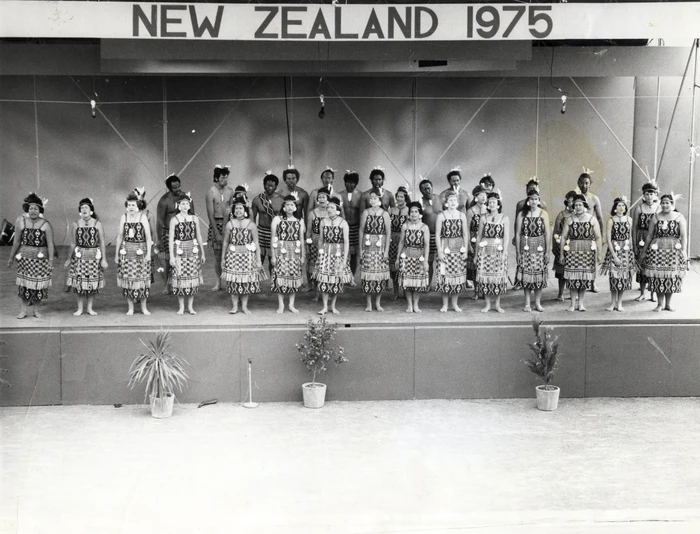Te Whare Tapere to Kapa Haka and Māori Concert Party - Part 1
"Kia kawea tātou e te rēhia : Let us be taken by joy and entertainment" - From “Whare Tapere”, Te Ahukaramū Charles Royal

Hero image: Mawai Hakona 1975; kapa haka nationals, Whangarei?. Upper Hutt City Library, accessed 03/07/2024, https://uhcl.recollect.co.nz/nodes/view/19452
The story of kapa haka is a tale of many milestones, developments, and progressions. These are neatly summarized in Te Ara Encyclopedia of New Zealand’s entry on Kapa Haka, where “Kapa” is described as a row of “performers” and kapa haka is acknowledged as both an ancient and a living art form.
A first example of kapa haka occurs in the pūrākau of Tinirau and Kae:
In the 19th century
This article, “19th-century kapa haka” – Te Ara Encyclopedia of New Zealand, describes kapa haka in the 1800s.
Concert groups (for tourism) were performing to audiences – especially at Rotorua. The kaupapa were delivered in te reo but the underlying melodies were European – thought to be more attractive to tourists who did not always warm to traditional mōteatea.
Māori concert parties made early trips abroad – Dr McGauran’s troup travelled to Sydney and Melbourne in 1862 and then to the United Kingdom the following year.
Traditional Māori ceremonies were always part of the welcome to Royal visitors — for Prince Albert in 1869, and later for Queen Elizabeth II in 1953-4.
In the 20th Century
Mākereti Papakura’s group toured Australia and United Kingdom, in 1910-1911:
- Mākereti Papakura – Dictionary of New Zealand Biography, Te Ara
- Photo of “Māori concert party, about 1911” (Dictionary of New Zealand Biography)
(Makereti Papakura is seated in the second row, third from left)
Te Puea Hērangi’s troupe, Te Pou o Mangatāwhiri toured the North Island from 1922, funding the building of Tūrangawaewae:
Te Puea formed a group named Te Pou o Mangatāwhiri. Its name commemorates the pou (post) erected by the Kīngitanga at Mangatāwhiri beyond which Pākehā were not to acquire land or authority, an injunction they ignored. Te Pou o Mangatāwhiri set out to raise the hundreds of pounds needed for the carved house by performing in halls and theatres throughout the North Island. Te Puea kept morale high on the tours, gathering the young people together to tell them stories and share her hopes with them, joking, jumping to her feet to show them how to improve their haka, how to pūkana.
Hērangi, Te Kirihaehae Te Puea – Dictionary of New Zealand Biography, Te Ara
- Celebrating our Maori Leaders — Te Kirihaehae Te Puea Herangi (maorieverywhere.com)
- Waiata: E noho e Te Rata (Ngā Taonga Sound & Vision)From part two of the recordings from the opening of Tūrongo House, Tūrangawaewae Marae, Ngāruawāhia (1938).
This is probably performed by Te Pou o Mangatāwhiri – with mandolin accompaniment, probably played by Tumokai Kātipa, Te Puea’s husband.
Apirana Ngata was a huge supporter of kapa haka as fundraisers for his Māori Soldiers’ fund. He also began, in 1929, to collect waiata for his Ngā moteatea volumes:

Apirana Turupa Ngata leading a haka at the 1940 centennial celebrations, Waitangi. Making New Zealand :Negatives and prints from the Making New Zealand Centennial collection. Ref: MNZ-2746-1/2-F. Alexander Turnbull Library, Wellington, New Zealand. /records/23012205
Read more:
- Apirana Ngata : e tipu e rea / King, Michael
- He tipua : the life and times of Sir Apirana Ngata / Walker, R. J.
Paraire Tomoana and E Pari Rā:
In the First World War Paraire Tomoana put his musical ability to patriotic use. He was in his 40s, too old and too valuable at home to go to war. Instead, he threw his energies into Ngata’s scheme of raising funds to invest for the benefit of the Māori soldiers who returned, and the children of those who did not. By June 1917 he had organised a song and dance group that gave performances to raise money for the Māori Soldiers’ Fund. The members would prepare songs for soldiers’ camps, for those at home, for battlegrounds, for work and for mourning.
Tomoana, Paraire Hēnare – Dictionary of New Zealand Biography, Te Ara